Top 6 LangChain Alternatives & Competitors
It’s well known that AI is reshaping almost all industries, with businesses scrambling to adopt working solutions. To meet this demand, a number of tools have come to market, aiming to streamline the development of AI-powered systems.
LangChain is at the forefront of this, as one of the biggest names in the agentic AI space. However, like any other software tool, this has its own distinct focus, target personas, and ideal use cases.
Today, we’re taking a fuller view of the options that are available to us here by checking out the top LangChain alternatives.
Specifically, we’ll be covering:
Let’s start with the basics.
What is LangChain?
LangChain is an open-source AI framework. This means that it provides a set of tools designed to help developers create autonomous, LLM-powered solutions.
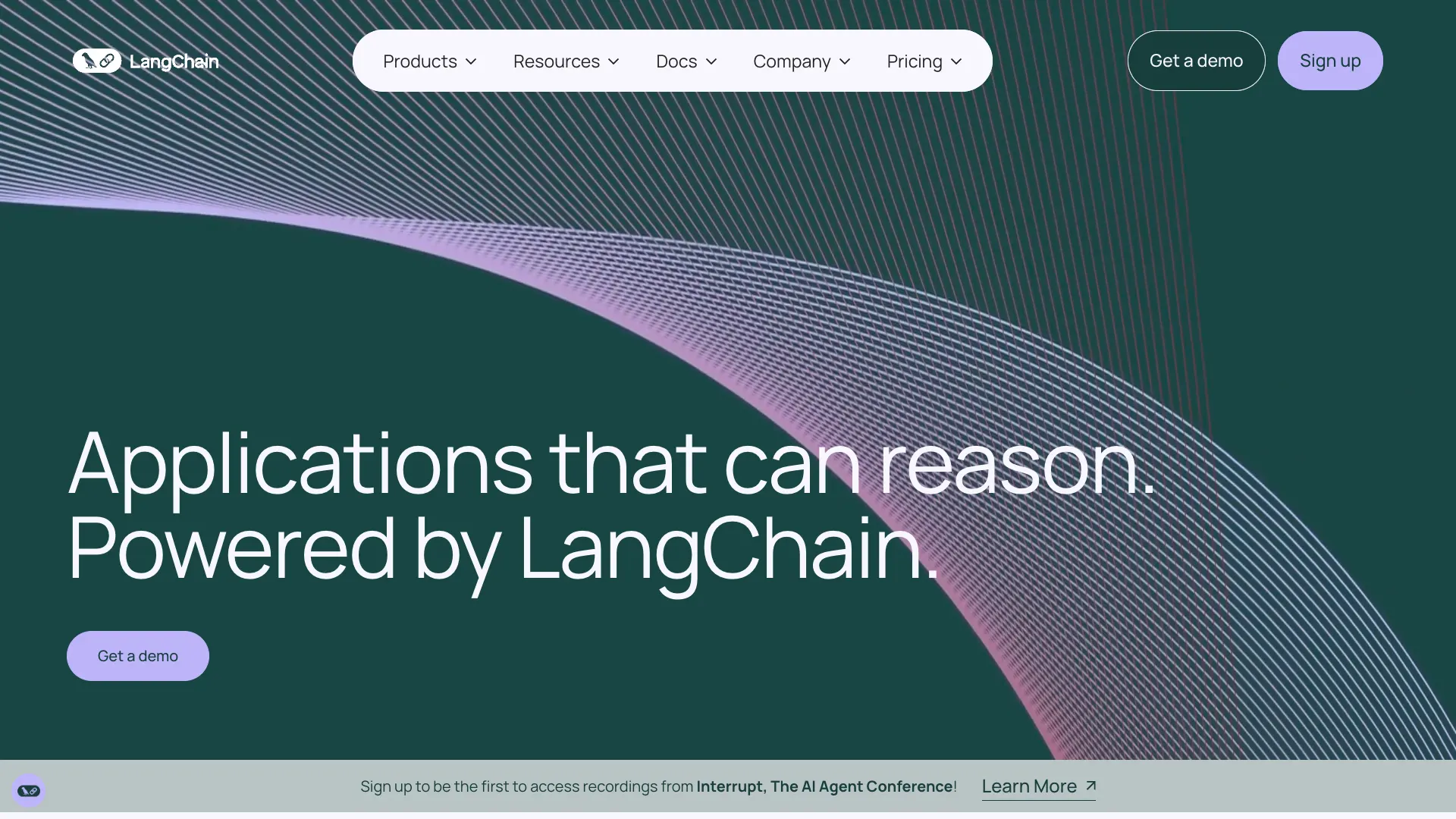
(LangChain Website)
More specifically, it offers a range of pre-built tools and functions for tasks like chaining prompts, facilitating memory, using tools, or interacting with external data. This facilitates more sophisticated AI behaviors than stand-alone API calls to an AI model.
The goal is to give developers a structured way to build complex applications with LLMs, including agents that can autonomously plan tasks, understand context, interact with APIs, and maintain memory across interactions.
To facilitate this, LangChain offers integrations with a range of LLM providers, including OpenAI, Anthropic, and Hugging Face, as well as a highly extensible, modular architecture, supported by a permissive open-source license.
Key use cases
With a better grasp of what LangChain is, we can begin to flesh out its positioning by thinking about its top use cases, along with the kinds of personas it’s optimized for.
We’ve already hinted at some of these, including referring to the idea of autonomy within AI-based systems.
More specifically, use cases for LangChain include:
- Agentic AI - Software systems that can act independently of humans in order to understand goals, plan tasks, and interact with APIs to reach a resolution.
- Retrieval augmented generation (RAG) - Combining LLMs’ training data with external sources to provide more reliable, verifiable answers.
- Conversational automation - Tools that enable users to trigger specific workflows or service requests from a natural language interface, such as enterprise chatbots .
- AI workflow orchestration - Chaining prompts, models, tools, and memory stores to execute complex, multi-stage workflows.
- LLM-powered internal tools - Internal applications, forms, or admin tools that leverage LLMs to perform tasks such as populating fields, analyzing inputs, or triggering backend tasks.
- Prototyping & experimentation - Iterating over prompts, toolstacks, and workflows in order to develop agent behaviors.
Notably, these types of solutions might be applied to a huge range of contexts and internal functions. For instance, agentic AI workflows might be deployed for internal services such as ITSM and HR, or customer-facing use cases.
It’s also important to consider the kinds of users that LangChain is primarily targeted at.
Generally speaking, it assumes a high level of technical knowledge and expertise. Indeed, it’s primarily aimed at developers, machine learning engineers, and other AI professionals.
As such, effective use will require familiarity with Python, API usage, and prompt design, along with relevant tools such as vector databases and NLP models.
So…
Why would we need a LangChain alternative?
As you might expect from what we’ve just said, one of the key reasons you might seek out an alternative to LangChain is because of the technical skills barrier. That is, non-developers, or those less familiar with AI, might find other tools better suited to their needs.
Even within the narrower scope of developer-focused AI frameworks, it’s also worth considering some of the key decision points that might make other tools more viable than LangChain for specific use cases.
Some of the most commonly cited concerns here include:
- Overhead & complexity - LangChain offers extensive flexibility, but some users report that this is excessive for more basic use cases, including requiring us to handle multiple abstractions for simple workflows.
- Visibility & observability - Some other platforms may offer better visibility into agent behavior out of the box, although we can also utilize LangSmith for this.
- Performance - Some users report that complex workflows can suffer from performance difficulties.
- Production-readiness - As a relatively young, open-source product, some teams might want to prioritize other solutions that offer better stability in production environments.
- Language & ecosystem support - LangChain is primarily built for teams that work in Python, so we might want to look elsewhere if this doesn’t suit our requirements or tool stack.
On the whole then, LangChain offers a highly capable solution for building advanced AI-driven systems, but, like any software tool, we must carefully consider whether or not this is the appropriate option for more specific use cases.
What to look for in an agent framework
In addition to the functional elements we’ve just considered that might sway us towards a LangChain alternative, we can also think about some of the more specific variables we’ll want to pay attention to when weighing up our options.
It would be impossible to give a full account of all of these. So, it’s helpful to break them up into the following themes and clusters:
- Achieving time-to-value - This includes factors such as how quickly we can learn to use a platform or framework, as well as any features, such as templates, that can assist us in developing working solutions more quickly.
- Developer experiences - Some platforms are primarily aimed at traditional development skills and workflows, while others might take a more low-code approach, enabling use by less technical colleagues.
- Scalability & long-term stability - Which features the platform offers for scaling usage, including caching, asynchronous execution, or distributed architectures, as well as support and SLA offerings.
- Integration options - Does the framework offer native connectivity for the tools we need? How easily can we create custom integrations?
- Production-readiness & operational support - Including visibility, observability, and monitoring, as well as other tools that we need in production environments, such as error handling, state persistence, or retry mechanisms.
- Costs and licensing - We must consider costs, license types, and associated resources that will be required to create and maintain production solutions.
- Vendor lock-in & ecosystems - Does the platform tie us into a particular type of tool stack? Additionally, are the tools in place to help us migrate to alternative solutions if we determine that it no longer fits our needs?
This requires careful consideration of our requirements across a range of technical, financial, and other issues.
6 LangChain alternatives for 2025
With a strong understanding of what we’re looking for, we can begin to outline some of the top LangChain alternatives and competitors on the market today.
We’ve chosen a range of platforms, giving a broad picture of the options that are available to us.
Specifically, our picks are:
Here’s a summary of how these stack up.
Great For | License | |
|---|---|---|
| LangChain | Developers building complex, flexible LLM workflows with modular components. | MIT |
| AutoGPT | Building complex multi-agent systems. | MIT |
| MetaGPT | Generating full-stack software using structured, role-based AI teams. | MIT |
| SuperAgent | Developers creating assistant-style apps with SDKs and fast iteration. | MIT |
| CrewAI | Coordinating multiple agents with task-based roles and reusable logic. | MIT |
| CAMEL | Research scenarios involving multi-agent cooperation and role-play setups. | Apache 2.0 |
| LlamaIndex | Connecting agents to structured & unstructured data for context-rich retrieval. | MIT |
Let’s check each one out in turn.
1. AutoGPT
AutoGPT is one of the most prevalent agentic AI frameworks. Like LangChain, it’s a Python-based, open-source agent framework, making it one of the most direct competitors in our round-up.
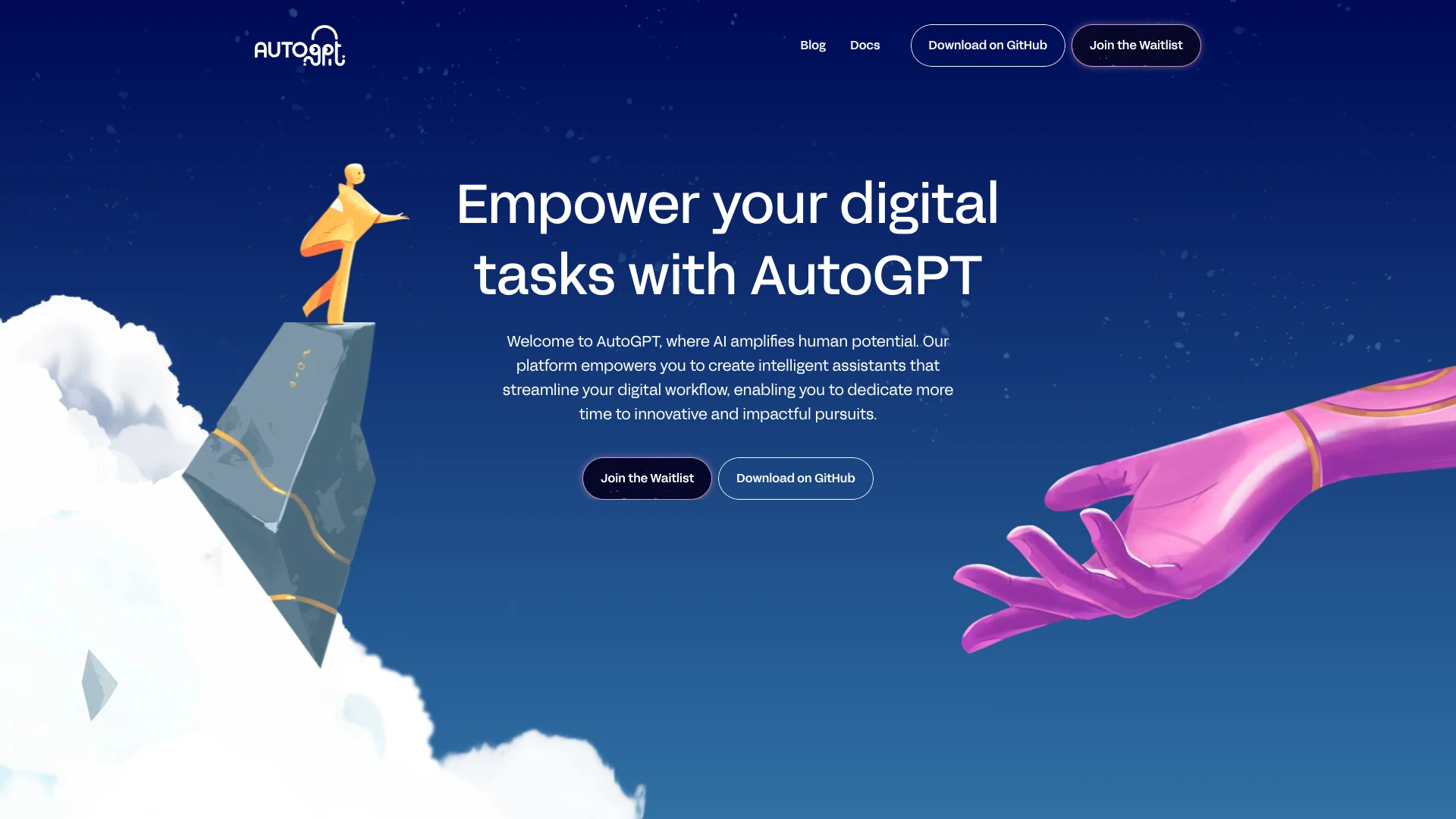
(AutoGTP Website)
Pros
One of AutoGPT’s particular strengths is its capabilities for building multi-agent systems. This makes it a strong choice for complex workflows, where we require an architecture that can support scalable tasks and high levels of delegation.
AutoGPT is also strong for use cases requiring Human-in-the-Loop systems. So, even as agents act autonomously, they can call on humans for judgment, intervention, or verification, enabling us to leverage AI in more high-stakes or sensitive workflows.
Additionally, AutoGPT is designed to be relatively easy to set up for Python developers, including Python-native design, integrations for common tooling, and a relatively straightforward installation process.
Cons
Compared to some other agentic AI platforms, AutoGPT is somewhat lacking in pre-built integration options that will be critical for enterprise usage. While it does offer strong extensibility, developers may be required to do more of the legwork here themselves.
On top of this, some users report issues with reliability. In particular, several sources mention that AutoGPT has a tendency to enter infinite loops, repeating the same actions without making progress.
Similarly, AutoGPT may offer more limited debugging and error-handling capabilities than some other platforms, which are important for production usage.
Licensing
AutoGPT is offered under the MIT license, meaning that it is free to use, modify, and distribute.
We can even integrate it into proprietary software.
However, this is caveated with the requirement that any distributed version, modified or unmodified, must retain the original license and copyright notice.
2. MetaGPT
Next, we have MetaGPT. This is a slightly different proposition to LangChain or AutoGPT, offering a framework for building agentic solutions within software development processes, more specifically.
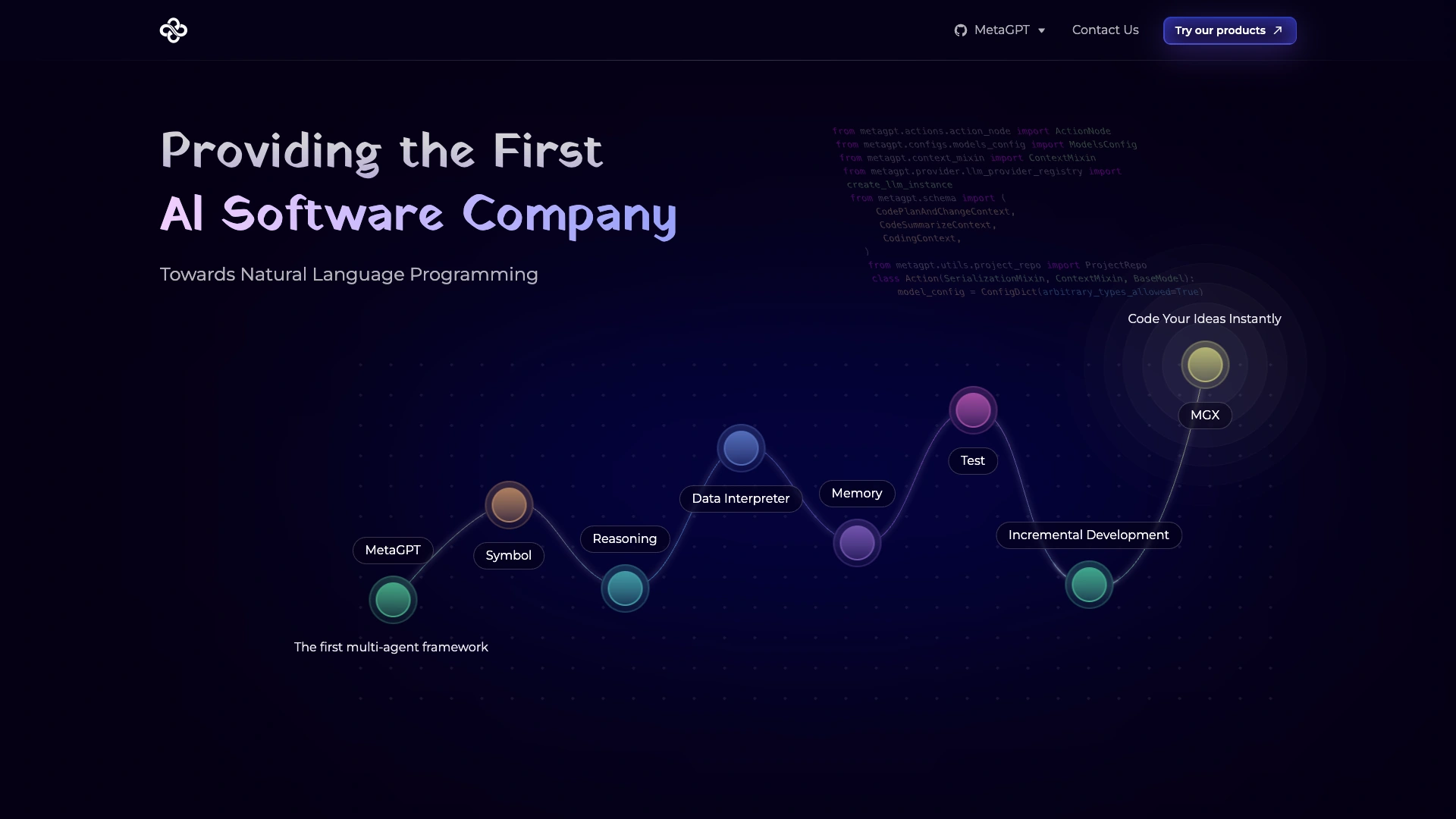
(MetaGPT Website)
Pros
MetaGPT offers a high level of optimization for its target use case. We can build complex systems that mimic real-world development teams, with specific roles for individual agents, as well as Standard Operating Procedures.
It also offers functionality specifically tailored to managing software projects from end to end, with a single line prompt. This includes creating user stories, competitive analysis, code generation, and more.
Compared to more general agentic AI frameworks, it also produces outputs of a higher quality for its specific use case. For instance, it offers a better chance of generating correct code on its first attempt.
Cons
One obvious downside of MetaGPT is its tight focus on such a specific use case. Whereas many LangChain alternatives will allow us to build agentic systems for all sorts of applications, it’s more limited in its scope.
Additionally, with its focus on running multiple specialized agents, MetaGPT can incur relatively high compute costs, and may be unsuitable for environments with lower GPU/CPU availability.
Compared to some more widely used platforms, it also has a relatively small community, which may mean we find certain integrations, resources, or other contributions to be somewhat lacking.
Licensing
Like AutoGPT and LangChain, MetaGPR is a free and open-source platform.
Again, it’s offered under the MIT license.
So, we can use, modify, and distribute it as we need, with relatively little limitation.
3. SuperAgent
SuperAgent is another open-source framework for creating AI agents. It also offers a cloud-based environment for deploying agents to production.
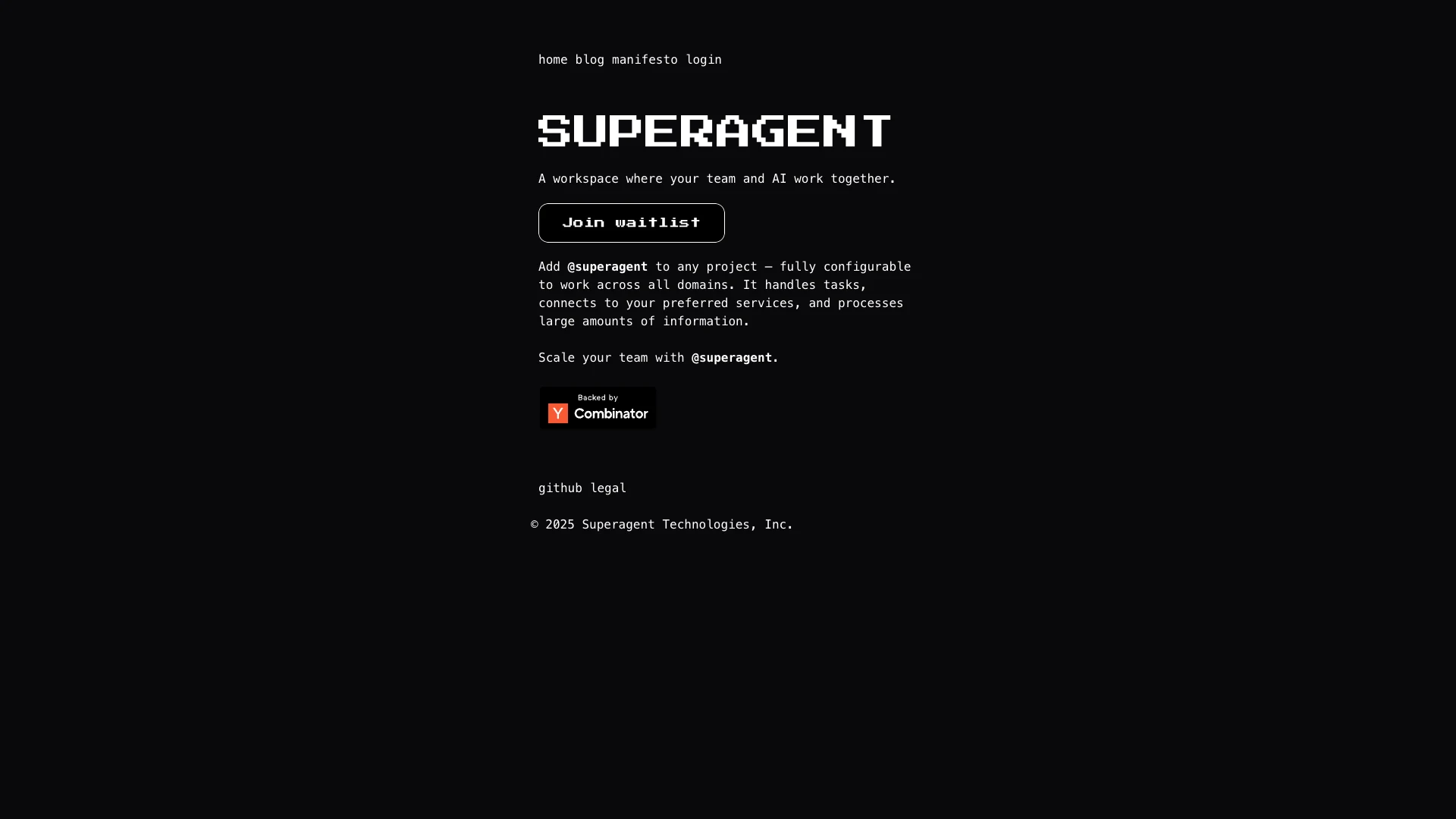
(SuperAgent)
Pros
SuperAgent’s cloud hosting could make it an attractive option for lean teams by significantly reducing infrastructure overhead. Developers can build agents without having to worry about managing runtimes, orchestrating containers, or provisioning servers.
It’s a highly extensible platform too, offering Python and TypeScript SDKs, along with a REST API, enabling developers to integrate agents with other application projects quickly.
As well as this, SuperAgent offers a range of native capabilities for advanced RAG use cases, including direct processing of raw documents into connected models. This enables agents to understand the full context of documents, rather than relying on segmented or summarized versions.
Cons
Compared to some of the other LangChain alternatives we’ve seen so far, SuperAgents may lack some of the functionality we need for more advanced agentic solutions. In particular, other platforms could be better suited to multi-agent workflows.
We may also require third-party tools for certain observability and debugging tasks, whereas other platforms have more comprehensive native tools.
SuperAgent is also a comparatively new platform, meaning that it may have a less extensive community and ecosystem of contributions.
Licensing
SuperAgent is also available for use, modification, and distribution under the MIT license.
However, information about their cloud platform, including licensing terms or commercial offerings, is quite sparse.
While using this will eliminate the need for infrastructure overhead, it’s possible that it will also introduce its own costs in the future.
4. CrewAI
CrewAI is an open-source framework aimed at teams that need to build complex, multi-agent systems.
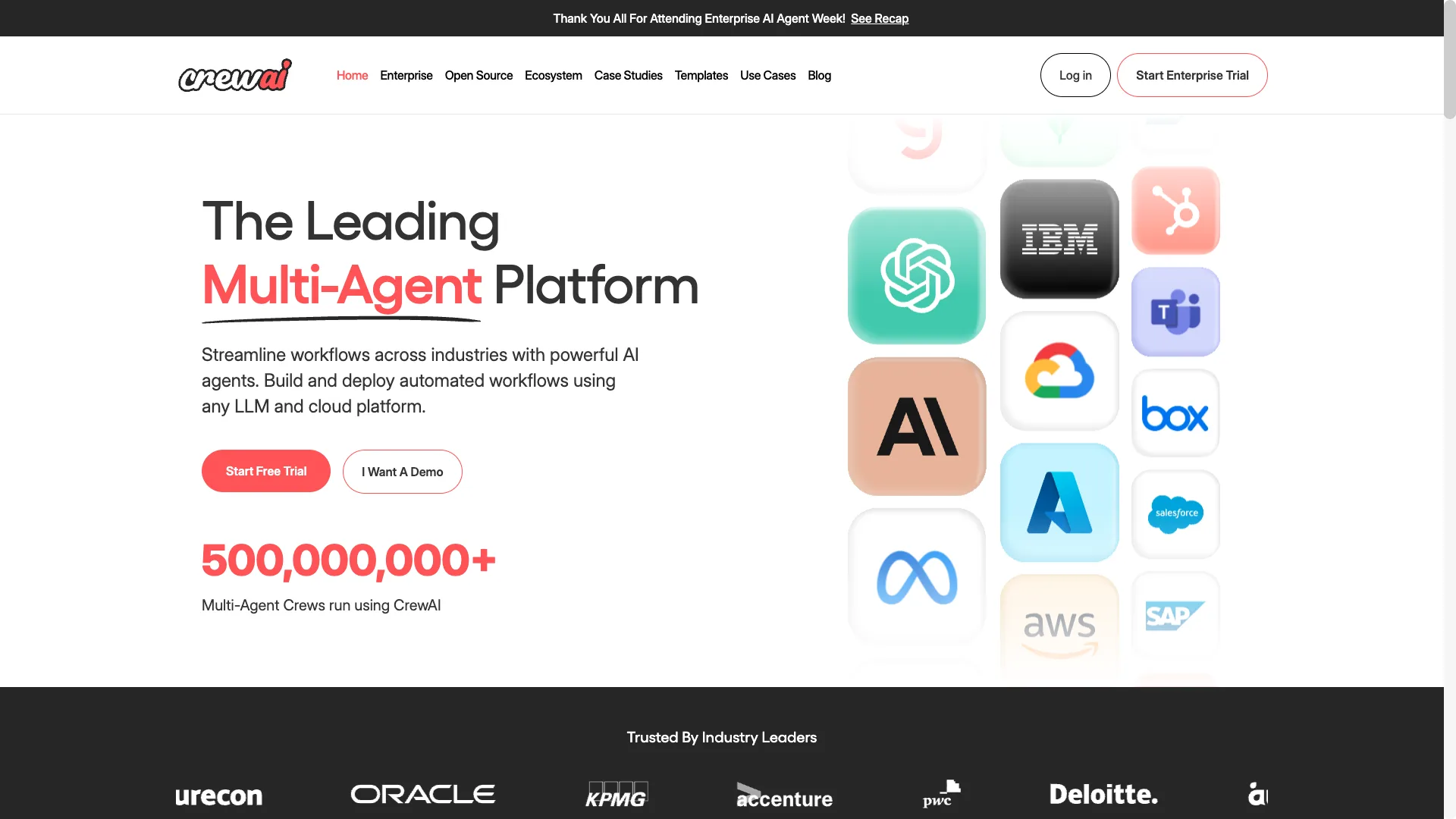
(CrewAI Website)
Pros
CrewAI is focused on empowering developers to create teams of specialist agents, known as Crews. Each is assigned a specific role, tools, and goals, allowing specialized contributions towards a wider task.
To support this, it also offers highly effective observability and monitoring. The Crew Control Pane enables developers to trace agent execution and agent behavior in real time.
CrewAI also benefits from a low-code interface for building agentic systems, in the form of Crew Studio. This could potentially open up agentic AI to a wider range of users, including colleagues with less technical expertise.
Cons
While CrewAI is an excellent choice for multi-agent workflows, some teams may find that other platforms offer more advanced capabilities for individual agent tasks, such as autonomous planning.
Some users report that CrewAI can suffer from performance issues when scaling to large-scale, high-throughput workflows.
On top of this, some users note that documentation for more advanced functionality can be less detailed, which may slow down the process of outputting working solutions.
Licensing
CrewAI is available as either an open-source or commercial platform.
Like other tools we’ve seen, the open-source version is offered under the MIT license.
Enterprise users can host on-premises or use a cloud platform. Pricing for this is custom, requiring us to contact CrewAI’s sales team directly.
5. CAMEL
CAMEL is another open-source AI agent framework. It’s generally focused on research applications, as well as experimentation with AI more broadly.
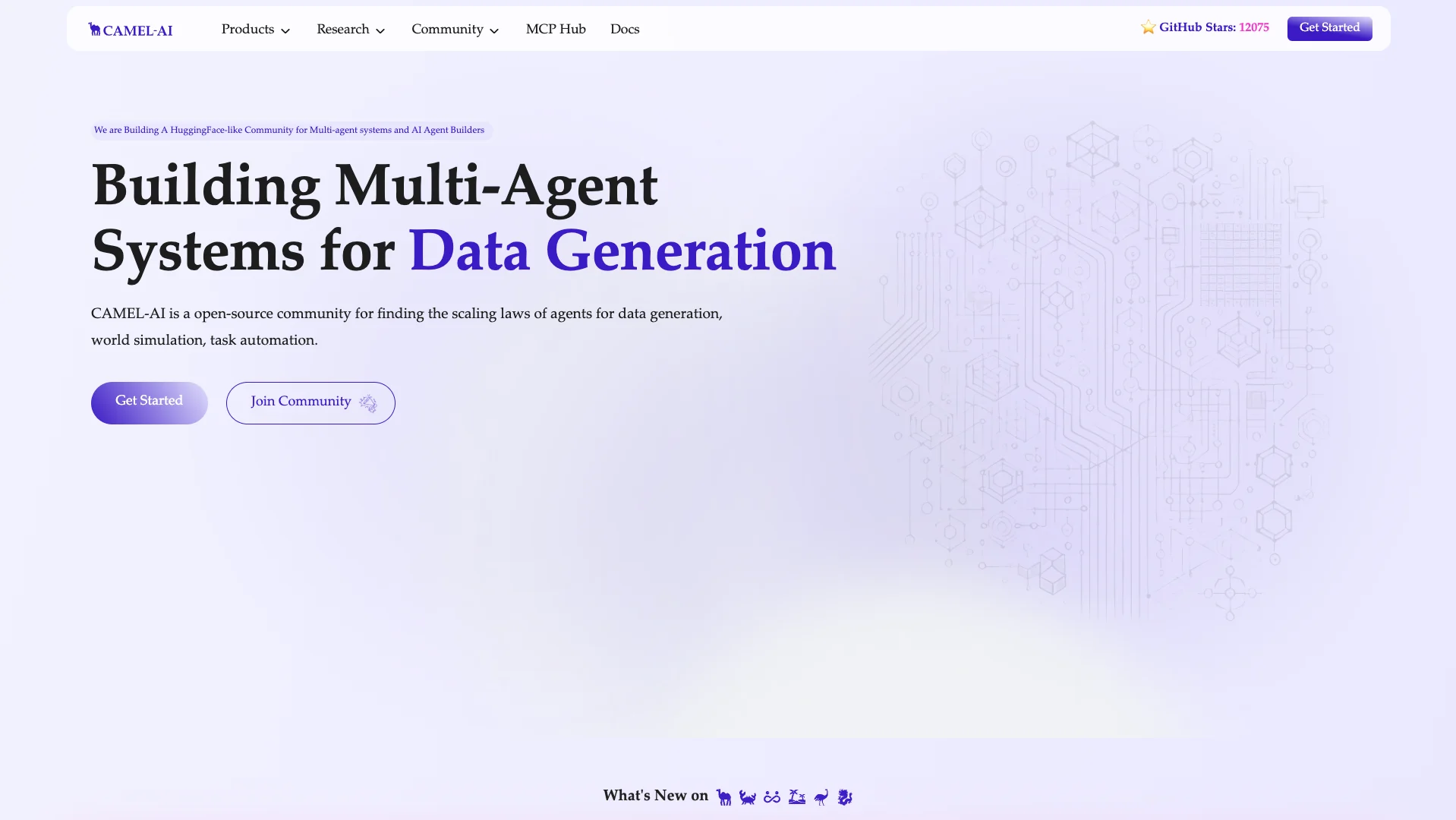
(CAMEL Website)
Pros
CAMEL is based around a ‘role-playing’ framework, where agents are assigned specific personas. They can then interact within workflows, delegating specific tasks based on their respective skills and tool exposure.
As part of its research focus, CAMEL offers a highly scalable approach, which can be used to model the behavior of systems featuring huge numbers of agents.
It’s also a particularly strong offering for data-related use cases, including specific functionality for synthetic data generation.
Cons
One downside of CAMEL is that it may offer a comparatively steep learning curve for beginners. It’s important to understand its architecture, including the role of constituent modules and how they interact with one another.
It also lacks extensive pre-built integrations for enterprise tools, which may make it difficult to use in a production environment for commercial workflows.
Similarly, some users note that it is prone to unpredictable behaviors, as well as performance issues.
Licensing
CAMEL’s core framework is offered under the Apache 2.0 license. This offers free usage, modification, and distribution.
This includes commercial use cases.
Some datasets are offered under CC BY-NC 4.0, allowing use for non-commercial purposes with appropriate attribution.
6. LlamaIndex
Lastly, we have LlamaIndex, a framework that helps developers to ingest, index, and query data in conjunction with LLM usage.
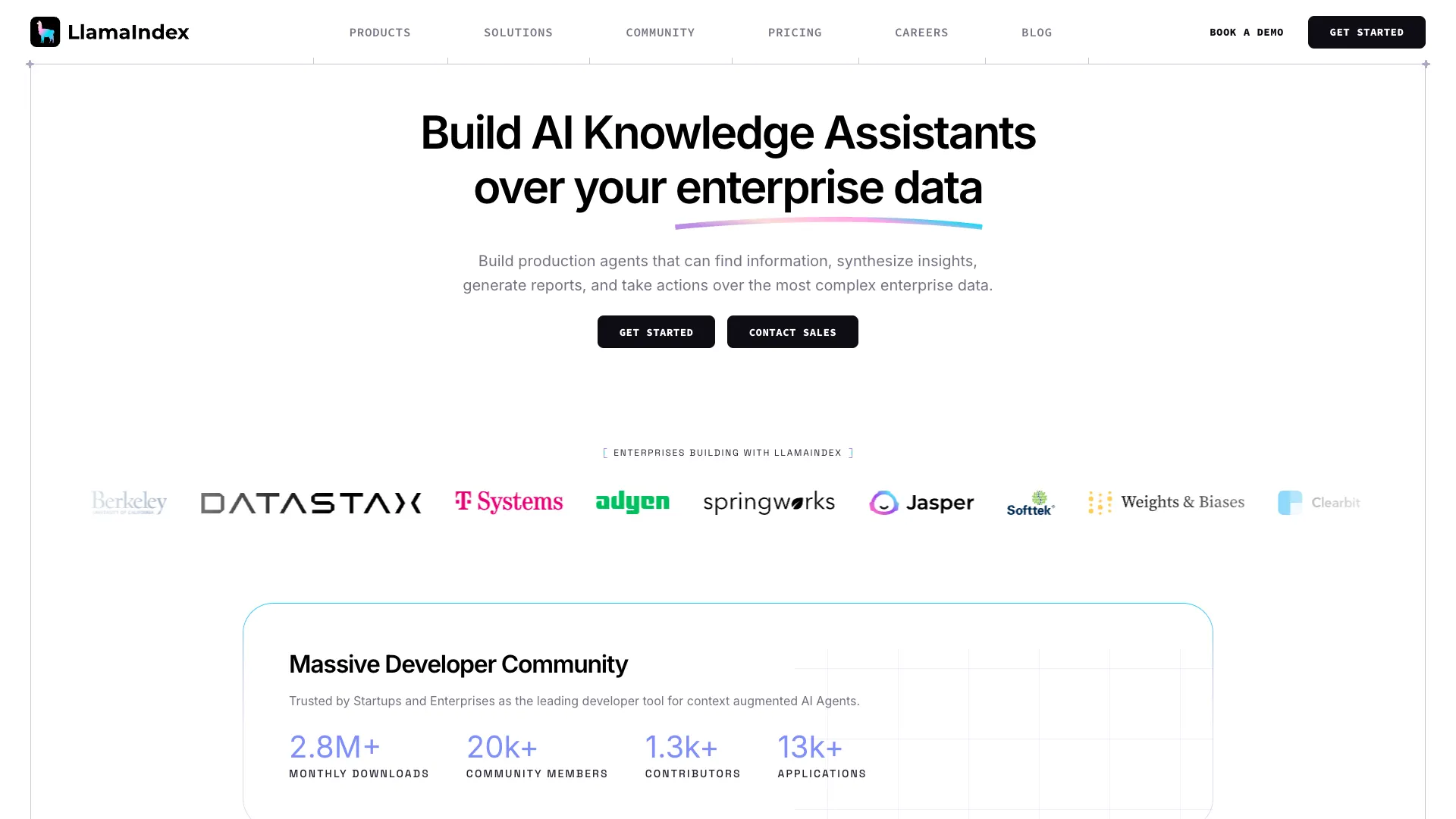
(LlamaIndex Website)
Pros
LlamaIndex is a strong choice for RAG-focused use cases, offering over 160 connectors for databases, documents, file systems, and API integrations.
As such, it’s highly effective in situations where agentic systems require accurate, context-aware data retrieval.
It also offers a highly flexible retrieval and memory architecture, including vector search, tree indices, and multi-step retrievers, which can form a part of wider agentic pipelines.
Cons
Some users note that LlamaIndex can be somewhat less intuitive than some other LangChain alternatives.
It’s also more focused on data and document-centric workflows, so we may wish to look elsewhere for different use cases.
It’s also a highly flexible and modular framework, but advanced use cases may require a higher level of technical expertise than some other options.
Licensing
Like most of the tools we’ve seen so far, LlamaIndex can be used, modified, and distributed for free under the MIT license.
There’s also a commercial product with usage-based pricing, along with a usable free tier.
This offers fixed license tiers, as well as custom enterprise pricing, making it a predictable, scalable choice for commercial usage.
Build workflow tools on top of any data with Budibase

Budibase is the open-source, low-code platform that empowers IT teams to turn data into action. We offer leading connectivity for all kinds of LLMs, RDBMSs, NoSQL tools, APIs, and more, with autogenerated UIs and a powerful, visual automation builder.
Take a look at our features overview to learn more.